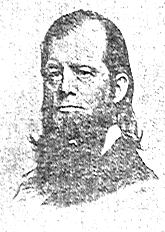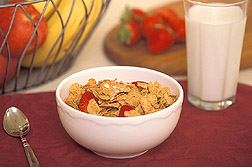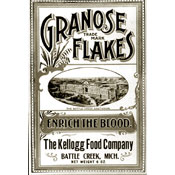I've been eating cereal for breakfast again lately, and also sometimes for an evening snack. One morning I was thinking about how I wanted to be sure I had my spoon and orange juice all ready before I poured the milk over the cereal, so the flakes would stay crispy for as long as possible. When I finally poured the milk, it struck me how strange it was to be pouring a liquid over this crunchy stuff that I wanted to stay crunchy.

(Photo from BBC News)
And why milk? Why not water, or some kind of juice? I know from having tried other things besides milk that I like milk on cereal best, but who first thought of putting milk on cereal? Did they try other liquids or beverages first, or has it always been milk and nothing else?
- Porridge is the oldest known form of cereal. It's basically oatmeal, and you can make it by cooking it either in water or milk. But dry cereals don't really come from porridges. They are descendants of crackers and biscuits.
- Dry cereals were invented in the United States in the 1860s.
- At that time, people were eating a lot of sausages or beef or even chicken for breakfast. Also at that time, people were going to places called sanitariums, which were like spas except they helped people improve their mental and spiritual as well as their physical health. Some doctors who ran these sanitaria wanted to offer their patients better food that would make them healthier in body and spirit as a result.
- An American Presbyterian clergyman, Sylvester Graham, advocated a vegetarian diet, and in 1829 he invented the Graham cracker, which used unsifted, coarsely ground flour.
- I can find no specific reference to Rev. Graham smashing up his crackers in milk, though that is how many children eat Graham crackers today, so it seems reasonable to think that people might have tried it that way back in the 1830s, too.

Graham crackers and milk. The healthy, sane breakfast?
(Photo from College Cookbook)
- In 1863, Dr. James Jackson was a vegetarian and he was in charge of the Dansville Sanitarium in Dansville, New York. He broke up hardened loaves of unleavened whole grain bran (reminiscent of the communion wafer, except bigger and thicker and tougher) into little pieces, then soaked them overnight in milk to soften them before serving them. He called this mixture Granula, after the word "granules" or bits of grain. This repast is generally regarded as the first cold cereal.

Dr. James Caleb Jackson, inventor of the first dry cereal, looks a little dry himself.
(Photo from New York History Net)
- A patron of his sanitarium, Ellen G. White, founded the Seventh-Day Adventist religion. She also established the Western Health Reform Institute in Battle Creek, Michigan, which offered outdoor physical exercise, oatmeal to eat, and Adventist theology for the soul. However, once her guests realized she did not have a doctor on staff, they did not come back.
- So she sent a member of her church, John Kellogg, off to Bellevue Hospital in New York to get a medical education. When Kellogg came back, he took over Sister White's Reform Institute.
- Dr. Kellogg was also a strict vegetarian, as required by his Adventist religions, and he also wanted to serve a healthy, vegetarian breakfast to his patients. In 1887 he made a biscuit out of oats, wheat, and corn meal. He called his invention Granula, too, but Dr. Jackson sued him and he changed the name to granola.
- Dr. Kellogg and his brother Will decided to try to make their granola even tastier for their patients, so they boiled the wheat first, then ran it through rollers to make a much thinner, cracker-like sheet of it. Then they toasted it and ground it up into meal -- much easier to chew and it softened more easily in milk.

John Kellogg on the left and Will Kellogg on the right. I would have thought John would be the severe-looking one, but no.
(Photo from The Detroit News)
I have to interrupt this history to insert some assumptions I've made. In recounting the events that followed, people stop talking about adding milk to the cereal in any way. But I'm assuming that the doctors / cereal inventors did either soak their granules in milk for a while beforehand, or they poured the milk over it prior to serving it. The first guy who made cereal had to add milk to make it edible, and it seems natural that the people who made it after him would include milk, too.

Cereal with milk -- good for you in oh, so many ways?
(Photo from the USDA's Agricultural Research Service)
I should also state that yes, it's true that many of these religious / health advocates thought that their new cereal inventions would also help people stave off their sexual urges.
- They thought that carnal desires and ill-health went hand-in-hand, one causing the other. If you improved your physical health you were less likely to indulge your lusty impulses and you'd be less likely to suffer the negative consequences to your health, which they thought included indigestion, headache, poor circulation, epilepsy, insanity, and oh all sorts of things.
- Eating cereal for breakfast was one way to improve your physical health, and therefore, one way to hold back the floodgates of sex that would in turn get you sick.
Now, back to the history of cereal.
- In 1893, a guy named Charles William (C.W.) Post went to the Kelloggs' sanitarium to recover from a nervous breakdown. While he was there, he got to like the food. His health didn't improve much, but he left with a revived interest in his previous plans to develop a coffee substitute made out of chicory, and to make his own breakfast cereals.
- A year later, he'd started his own sanitarium, the La Vita Inn. There, he developed Postum Cereal Coffee, his chicory coffee-substitute to be drunk in the morning with cereal, and what we now call Grape-Nuts cereal. He marketed the heck out of his products and made boat-loads of money.
- Back in the Kelloggs' sanitarium, one night in 1894 the Kellogg brothers accidentally left a pot of their boiled wheat out overnight. The next day they ran it through the rollers to see what would happen, and instead of coming out as one flat sheet, it emerged from the rollers as flakes. The first flake cereal was born. They called it Granose.

The label for Granose wheat flakes. Just how they were supposed to enrich the blood, I'm not sure.
(Photo from Mr. Breakfast)
- Despite the terrible name, the Kelloggs' patients loved the cereal, and even started asking it to be shipped to them in the mail. Will tried to persuade his brother to ought to sell their cereal to grocery stores, but the strict professional doctor did not want to compromise his medical ethics.
- Will Kellogg, who was an Adventist like his brother but was not a doctor, had no problem with selling and shipping their cereals. He bought out John's portion of the cereal patents and founded the Kellogg Company.
- He also came up with a way to make the same flake cereal using corn. His company went on to package and sell millions of boxes of Sanitas Corn Flakes (later, he dropped the "Sanitas"), and other cereals besides.
- Shortly after Will started selling his Corn Flakes, C.W. Post came up with his own flake cereal, which at first was called Elijah's Manna. He later re-named it Post Toasties.
- You'll notice that the Post vs. Kellogg's competition which started way back at the very beginning of cereal as we know it rages on today.
- Cereal makers are also still caught in that same weird struggle between commercial success and being concerned about people's health.
- They're still trying to make their cereals more healthy -- they add B vitamins, they put the words "whole grain" on the box, and so on. At the same time, they're trying to get more people to buy and eat it -- they add sugar or get some animated bee to sell it for them.

Edit: Happy 70th birthday, Cheerios!
Little fact about Cheerios: they're made by heating balls of dough then they get shot out of a puffing gun at 100 mph.
Sources
Mr. Breakfast, The Early Days of Breakfast Cereal
Answers.com, Cereal
Patricia Zacharias, "Snap, Crackle and Profit -- the story behind a cereal empire," The Detroit News
Mary Bellis, About.com, The History of Breakfast Cereals
International Vegetarian Union, Sylvester Graham (1795-1851)
The Straight Dope, Is it true graham crackers were invented to cure the dread fever of lust?
Defense Logistics Information Center, The Battle Creek Sanitarium Years
Porridges message board Jan 23, 2006 Q&A Re: cold cereal and milk
Fitness and Freebies, The History of Cereal August 7, 1987
awesome. thanks. i was just eating cereal for dinner and also thought it was wierd that i was pouring milk over it without any hesitation, thanks for the info.
ReplyDeletethis was the exact thing I was wondering about this morning! I was searching this topic up after breakfast and voila! the perfect one-stop shop for info. thanks!
ReplyDeleteSo cool. This is awesome! Another question:
ReplyDeleteHow were chips invented?